
No, of course he doesn't. But James Earl Jones, the acclaimed actor and the voice of Darth Vader, does. And so a few years ago, the PNG and ANA produced a couple of videos promoting coin collecting with Mr. Jones as the narrator. We encourage you to check them out!
The following was written by Brian.
One of my favorite bands when I was growing up was Aerosmith. They were (and technically still are) “The Bad Boys From Boston.” One of my favorites of theirs was a little ditty called “Back in the Saddle.” In the song, they wanted the sound effect of a bullwhip being cracked so they went out and bought a real one. Reportedly all four members were cut up and injured several times trying to use it but still couldn’t get it to work. So, they improvised (pun intended) by swinging a 30-foot cable that was in the recording studio and using a cap gun to emulate the crack of the whip.
These days, I’m feeling like we are back in the saddle at Northeast (minus attending the usual coin shows). It was a very strange (and dare I say challenging) few months prior to getting back in the groove. We had to improvise quite a bit ourselves, but we all came together to make it work. And we’re still making it work. Lots of safety protocols are in place, and everyone has been doing a stellar job with boundary considerations, mask wearing, sanitizing, etc. With a good bit of improvising, we have been able to come back to full speed ahead from the operations standpoint.
That said, we’d like you to know that none of this would have been possible without you, our customers. Without your support, we, like many other businesses, would have been in very rough shape. So, we thank you for your loyalty, your business, and your patience! Many of you have expressed over the phone that you understand things take a little longer during a pandemic and though we have not slowed down, we certainly appreciate the sentiment.
Thank you again for allowing us to get back in the saddle once more!
One of my favorites too Brian. Also love "Last Child" from that album - and I was my family's last child. Was fortunate to see them at the Cow Palace in S.F. not too long after Rocks came out. I believe it was 1976, when I was 17 - awesome show!
The following was written by Tom.
In a recent collection we acquired we were told in advance about a popular variety that was included. Popular not necessarily due to scarcity but more due to the clever name it was given decades ago when first discovered. A “Spitting Eagle” is well-known as a variety of 1891-CC Morgan dollars. It is usually only offered in mint state due to decent quantity that came out of the Redfield hoard in the early 1970’s. It is a variety that sells well and is popular among collectors due to the die break below the eagle’s beak, thus giving the coin its fun name.
What we were not expecting was what we got. Not a Morgan dollar at all but a somewhat recently discovered Washington quarter variety given this same name. We were completely unaware of the existence of a “Spitting Eagle” 1983 Washington quarter. It is even more pronounced than the Morgan dollar variety, with a heavy die break from the the eagle’s beak on the quarter’s reverse.
Goes to show that just when we think we have seen it all, there’s always new discoveries and new things to learn. It keeps our hobby and business interesting for sure.
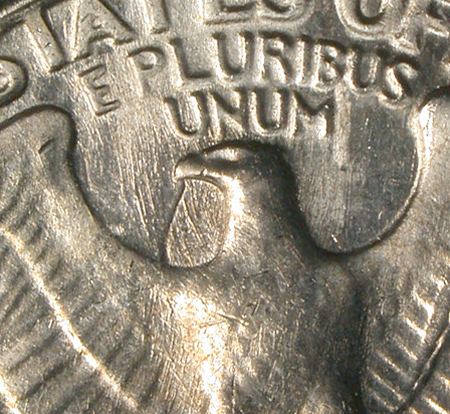
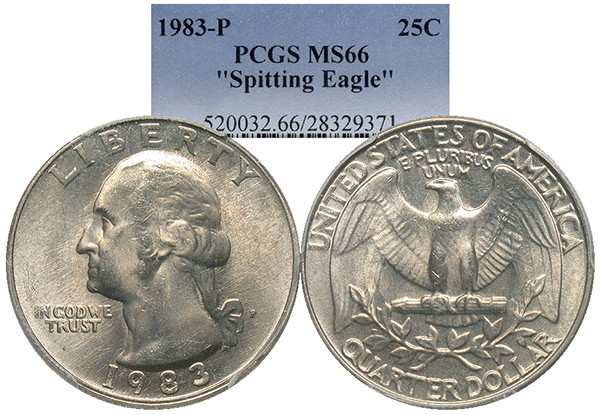
The following was posted by Marne.
I don't know about the rest of you, but I enjoy coins with animals on them. Almost every coin features an animal of some kind. My favorite animal on a coin would have to be the owl. Owls are fascinating creatures. They are nocturnal solitary birds of prey, with feathers that are silent, binocular vision, and binaural hearing. Owls can be found almost anywhere on Earth, with the exception of the polar ice caps and a few remote islands. A group of owls is known as a "parliament".
Owls have long fascinated civilizations througout time. In Ancient Greece, the owl was a symbol for Athena, goddess of wisdom and strategy. According to myth, 'an owl sat on Athena's blind side, so that she could see the whole truth.' A symbol of a higher wisdom, and a guardian of the Acropolis.
In the modern West owls are associated with wisdom and vigilance. Harkening back to Ancient Greece, as Athena was known for wisdom.
The First Nations Peoples of the Americas considered owls bearers of supernatural danger. The Apache and Seminole told children the hooting was from "bogeymen" (possibly to get them to behave and go to bed!)
Owls were thought to carry messages back and forth beyod the grave.
The Aztecs and Maya knew the owls as a symbol of death, often depicted with the Aztec god of death Mictlantecutli.
In Mexico there is a phrase "Cuando el tecolote canta, el indio muere" ("When the owl cries/sings, the Indian dies").
The first owl coins were minted around 510 BC. The Athenian Owl was the first coin with a full design on both the obverse and reverse. The phrase "heads or tails" originated with this coin!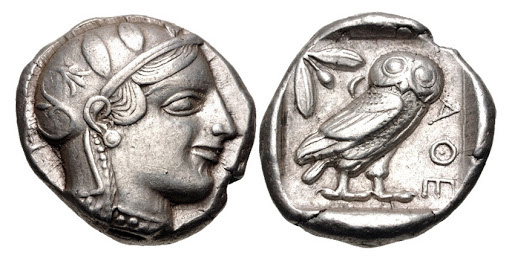
The "Owls" as they were known were minted to a standard of purity and weight. This contributed to their success as the premier trade coin of their era. This made them a widely used coin, often used to make large payments, or hoarded.
The silver Tetradrachm is thought to be the coin given to Judas for betraying Jesus.
The owl is also featured on the 2016 German Domestic Birds coin series.
1/8 oz 20 Euro Gold Uhu 2018
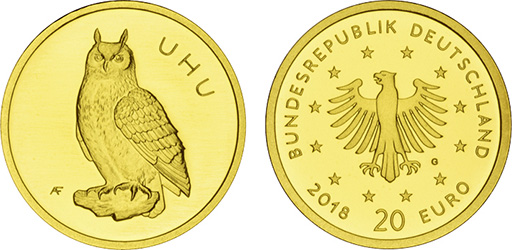
This 2011 Wildlife Protection coin of Mongolia has Swarovski crystal eyes.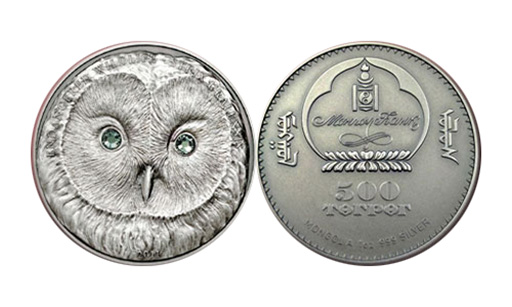
The Ukraine Bubo
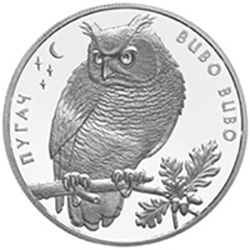
In the United States in 1915 at the San Francisco Panama-Pacific Expo, the first $50 gold coin was released in commemoration. Mintages were 1,509 of the $50 Gold Octagonal and 1,510 of the $50 Gold Rounds. Due to cost, few sold and approximately 1,017 $50 Gold Rounds were destroyed.
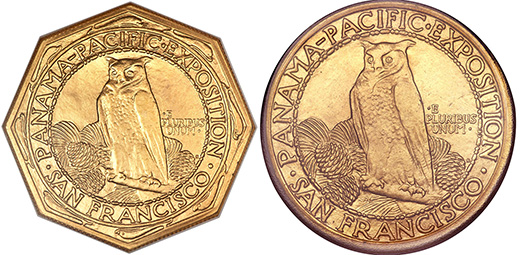
What coins with animals fascinate you?
I most like the DoDo bird!
Now we can't see a real DoDo bird, but can find it on a 1971 MAURITIUS silver coin.
*I bought this coin in 2018 from NorthEast.
The following was written by Brian.
I recently came across the term 'haymarks' and was a bit mystified as to what that could mean. I searched a bit and found that while most agree that the term refers to older British coins, there is quite the variance when it comes to what they are and how they are produced. Check out the Fourpence, and you'll see clearly that there is something sort of streaky going on with the surfaces throughout the fields and across the devices.
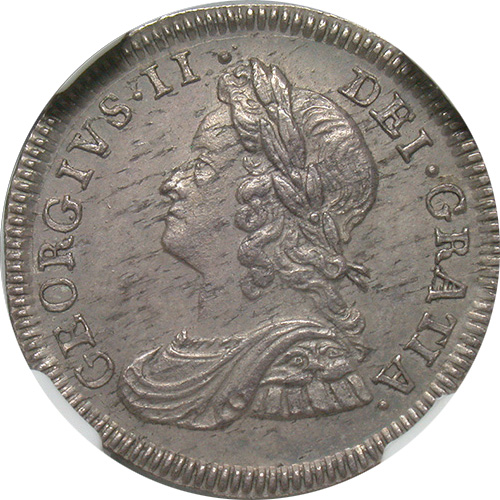
What the hay, I say?
A few sources returned mixed results…
From a British coin site:
Hmking - haymarking. These terms refer to flan surface faults resulting from metal mix. They are essentially dark scars caused during and not damage subsequent to minting.
But this explanation from an old Heritage Auction does seem to have some validity to it: "probably net-graded to a "62" because of the entirely normal black streaky flecks in the metal, sometimes called "haymarks," caused by the alloyed silver containing tin, which came in part from Midlands and Welsh mines.
Further complicating matters, various coin forums on this subject find a number of British coin dealers "don't use this term" and "I am British and I call them hairlines" which is totally ridiculous because that's like saying Santa Claus doesn't exist and neither do run-on sentences.
Some say it is merely a language thing where haymarks is just a word used in Britain for hairlines.
Or it could all just be a bunch of hooey! Feel free to weigh in with your expertise on this subject should you want to. We would be glad to hear your thoughts!




